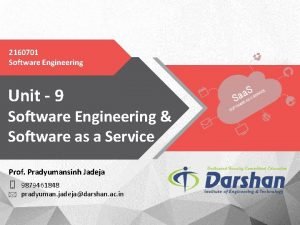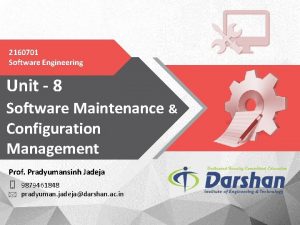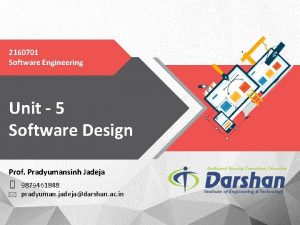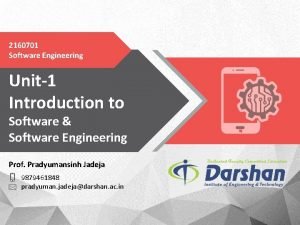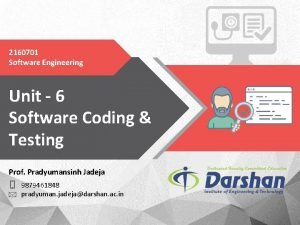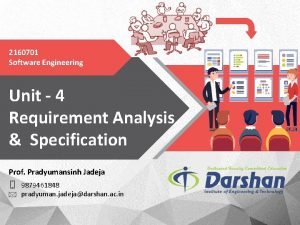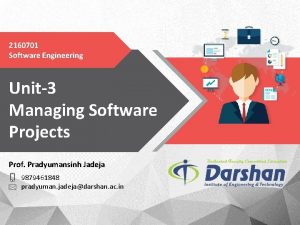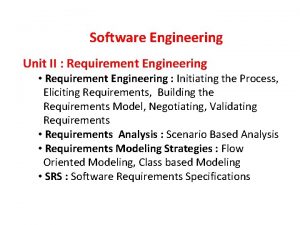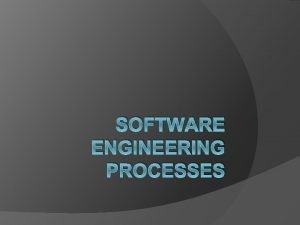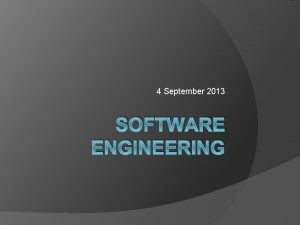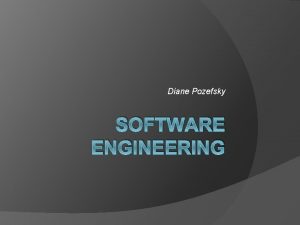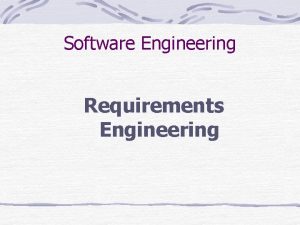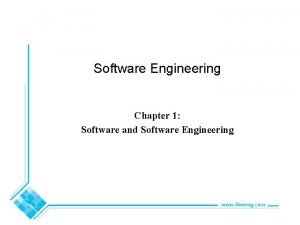2160701 Software Engineering Unit 9 Software Engineering Software

















- Slides: 17

2160701 Software Engineering Unit - 9 Software Engineering & Software as a Service Prof. Pradyumansinh Jadeja 9879461848 pradyuman. jadeja@darshan. ac. in

Outlines § Software as a Service • Saa. S Architecture § Product Lifetime • Independent Product Vs. Continues Improvement Software as Services (Saa. S) 2 Darshan Institute of Engineering & Technology

Software as a Service § Saa. S (Software as a Service) describes any cloud service where consumers are able to access software applications over the internet • Google, Twitter and Facebook are all examples of Saa. S, with users able to access the services via any internet enabled device • Enterprise users are able to use applications for a range of needs, including accounting and invoicing, tracking sales, planning, performance monitoring and communications § Saa. S is often referred to as software-on-demand utilizing it as renting software rather than buying it § With traditional software applications you would purchase the software upfront as a package and then install it onto your computer Software as Services (Saa. S) 3 Darshan Institute of Engineering & Technology

Software as a Service cont. § The software’s license may also limit the number of users and/or devices where the software can be deployed § Software as a Service users, however, subscribe to the software rather than purchase it, usually on a monthly basis § Applications are purchased and used online with files (data files) saved in the cloud rather than on individual computers Software as Services (Saa. S) 4 Darshan Institute of Engineering & Technology

Software as a Service Cont. Benefits of Saa. S to organizations and personal users No additional hardware costs Updates are automated No initial setup costs Accessible from any location Pay for what you use Cross device compatibility Usage is scalable Applications can be customized Software as Services (Saa. S) 5 Darshan Institute of Engineering & Technology

Software as a Service Cont. § Office software is the best example of businesses utilizing Saa. S § Tasks related to accounting, invoicing, sales and planning can all be performed through Software as a Service. § The required software can be subscribed via the internet and then accessed online via any computer in the office using a username and password. § If needs change they can easily switch to software that better meets their requirements. § Everyone who needs access to a particular piece of software can be set up as a user § whether it is one or two people or every employee in a corporation. Software as Services (Saa. S) 6 Darshan Institute of Engineering & Technology

Saa. S Summary § There are no setup costs with Saa. S, as there often are with other applications § Saa. S is scalable with upgrades available on demand § Access to Software as a Service is compatible across all internet enabled devices § As long as there is an internet connection, applications are accessible from any location Software as Services (Saa. S) 7 Darshan Institute of Engineering & Technology

Saa. S Architecture Traditional Software Delivery Model Saa. S Model Software as Services (Saa. S) 8 Darshan Institute of Engineering & Technology

Saa. S Architecture (Cont…) § The diagram illustrates the key differences between the traditional software delivery model and a Saa. S-based delivery model • In essence, all users of Saa. S-based applications run exactly the same code with customizations and configurations stored as metadata parameters § The key difference between Saa. S and traditional software delivery is that Saa. S-based applications are fully hosted within some form of Data Centre environment • All updates to the Saa. S application are carried out within the Data Centre and therefore the user can always be assured that they are using the most recent version of the application • These applications are designed to work and take advantage of operating within a web browser-based environment Software as Services (Saa. S) 9 Darshan Institute of Engineering & Technology

Saa. S Architecture (Cont…) § Since nearly every computer comes with a browser as part of the operating environment, there is hardly any implementation work required by a company’s IT department § This allows the IT department to focus on other activities reducing support costs § Saa. S is traditionally sold on a subscription basis that includes upgrades, maintenance and some level of basic support § These subscriptions operate on a monthly, quarterly or yearly basis § Saa. S is ideal for companies who would be using the application periodically Software as Services (Saa. S) 10 Darshan Institute of Engineering & Technology

Product Lifetime § In order to understand the engineering process for the software, it is essential to contrast software and hardware engineering with respect to product lifetime. § The concept product life time concerns the life of product in the market with respect to business or commercial cost and sales measures § The time period of product life and the length of each stage varies from product to product • Lifetime of one product can be over in few months and of another product may last for many years Software as Services (Saa. S) 11 Darshan Institute of Engineering & Technology

Product Lifetime (Cont…) § There are three assumptions made for product lifetime 1. Products have a limited life and thus every product has a life cycle 2. Product sales pass through distinct stages, each posing different challenges, opportunities and problems to the seller 3. Products require different marketing, financing, manufacturing, purchasing and human resource strategies throughout its lifetime § Product lifetime is an important factor for the difference between hardware and software § There are two important approaches for product lifetime 1. Independent Product 2. Continuous Improvement Software as Services (Saa. S) 12 Darshan Institute of Engineering & Technology

Independent Product Vs. Continues Improvement § Hardware design must be created and implemented completely before they get deployed at the working environment § On the other hand, software is expected to grow and evolve over time § The cost for upgrade of hardware is very expensive while software upgrade is normally affordable § Hence, software is getting improved at each new release or version while hardware decay (waste) into obsolescence (unused) § As hardware product is not getting better over the time, customer expects it to be completely bug free and independent product when it is launched Software as Services (Saa. S) 13 Darshan Institute of Engineering & Technology

Independent Product Vs. Continues Improvement Cont. § If it is not working properly, • then customer thinks it faulty and returns the product immediately and the manufacturing company has to bear the loss § On the other hand, even if there are some problems in the software during installation, • customer install the latest versions or updates thinking that one day or other the problem will get resolved § The main reason behind it is the continuous improvement in software development • There is a tendency of using improved versions of the software over its lifetime • In fact long product life of software means maintenance and enhancement of the software continuously Software as Services (Saa. S) 14 Darshan Institute of Engineering & Technology

Independent Product Vs. Continues Improvement Cont. § Thus the successful software can live decades and is expected to evolve and improve continuously § While the computer hardware is finalized at the time of manufacturing and can be considered obsolete within just few years Software as Services (Saa. S) 15 Darshan Institute of Engineering & Technology

Continuous Improvement Tasks The continuous improvement tasks are Review product, processes and practices periodically Conduct frequent retrospectives (looking back in the past) and experiments to continually improve team Gather feedback from stakeholders Develop a team of specialists by providing learning opportunities Perform analysis on existing processes to remove wastes and improve efficiency Disseminate (expand) knowledge gained during project works to the whole organization for organizational improvement Software as Services (Saa. S) 16 Darshan Institute of Engineering & Technology

Summary § Software as a Service • Saa. S Architecture § Product Lifetime § Independent Product Vs. Continues Improvement § Continuous Improvement Tasks Software as Services (Saa. S) 17 Darshan Institute of Engineering & Technology
 2160701
2160701 2160701
2160701 Unit 6 review questions
Unit 6 review questions Computer based system engineering in software engineering
Computer based system engineering in software engineering Forward engineering and reverse engineering
Forward engineering and reverse engineering Software maintenance process models ppt
Software maintenance process models ppt What is software implementation in software engineering
What is software implementation in software engineering What is software metrics in software engineering
What is software metrics in software engineering Types of software crisis
Types of software crisis Software measurement and metrics
Software measurement and metrics Real time software design in software engineering
Real time software design in software engineering Design principles in software engineering
Design principles in software engineering Suatu lembaga yang
Suatu lembaga yang Right triangle trigonometry examples
Right triangle trigonometry examples English system of measurement
English system of measurement Algebra 2 unit test
Algebra 2 unit test Perhitungan unit cost rekam medis
Perhitungan unit cost rekam medis Unit process and unit operation
Unit process and unit operation
